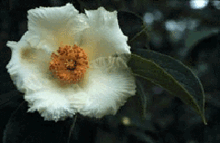Stewartia ovata
| Stewartia ovata | |
|---|---|

| |
| Flower | |
| Scientific classification | |
| Kingdom: | |
| (unranked): | |
| (unranked): | |
| (unranked): | |
| Order: | |
| Family: | |
| Genus: | |
| Species: | S. ovata
|
| Binomial name | |
| Stewartia ovata | |

| |
| Range | |
| Synonyms[1] | |
| |
Stewartia ovata, sometimes spelled Stuartia ovata, known commonly as Mountain Camellia, is a species of Stewartia native to low to mid-elevations in the southern Appalachian Mountains and nearby regions from Mississippi to Virginia. A relative of the evergreen Camellias of Asia, other common names include summer dogwood and Mountain Stewartia.
Although not endangered, the plant does have a limited range and is considered to be rare. Mountain Camellia grows in the understory of predominately hardwood forests and tends to be found near streams, usually at elevations below 800 m (2,500 feet).
Description
Stewartia ovata is a deciduous flowering shrub or small tree growing to 5 meters (16 2/3 feet) tall, with smooth, flaking grayish-orange bark. The leaves are oval with an acute apex, 7–13 cm (2.8-5.2 inches) long and 3–6 cm (1.2-2.4 inches) broad, and turn orange, red, or gold when the tree becomes dormant in the fall. The flowers are camellia-like, 6–12 cm (2.4-4.8 inches) in diameter, with five white petals and numerous white, yellow or purple stamens; they appear in early to mid-summer.[2]
- Varieties
There are two varieties:
- Stewartia ovata var. ovata — flowers 6–8 cm diameter, stamens white to yellow.
- Stewartia ovata var. grandiflora (W.J.Bean) Weatherby — flowers up to 12 cm diameter, stamens purple.
